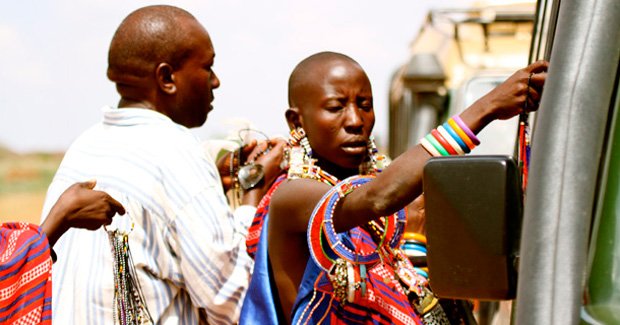Australian Geographic Adventure goes wild in Kenya: negotiation

Amy gets an education in Kenya culture and begins to feel right at home – almost.
ONE OF THE GREATEST gifts travelling gives you is the chance to immerse yourself in cultures that are vastly different to your own. When you’re tramping across a foreign land and you want see, hear and taste as much as humanly possible, it often feels like your time is far too precious to be spent being idle. But, if you allow yourself a few quiet moments to kick back and observe, it’s amazing what you can learn.
For one, Kenya has taught me to be a better negotiator. Prior to this adventure, I would have owned up to being the world’s worst barterer. As far as I was concerned, if something has a price on it, that’s what it costs. End of story. So pathetic were my haggling skills, I’ve often shamefully called upon travel companions to do my dirty work for me, as I loiter in the background pretending not to listen while they effortlessly manage to swindle me a better deal.
Honestly, I blame our society. Imagine the look of horror you’d be met with at your local Woolworths if you turned to the checkout person and announced, “No, $4 for two avocados is a little steep – I’ll give you $2.50.”
Haggling is part and parcel of the sale of crafted goods in Kenya and as a buyer you’re expected to drive a hard bargain. With this in mind, I was determined to master the art of negotiation this past week, and I’ve had plenty of opportunities to practice.
Local tradespeople and craftsmen approach us constantly: they stop for a chat while we’re at a standstill in traffic, brazenly open our car windows and unload their wares as we’re waiting to be admitted at park gates; and they trail us persistently as we walk through town. You can actually hear their calls of “Mr/Mama I have something here for you,” long before you’ve spotted them running towards you, hurriedly waving their goods and shackles to try and capture your attention.
As a girl used to browsing and shopping at a leisurely pace, I found these methods initially a little confronting, and my first attempt to nab a bargain passed in a flurry of broken English at the gates of Amboseli NP, after which I walked away with 12 more necklaces than I’d planned on buying.
Slowly though, I’ve developed a formidable game face and learnt some invaluable lessons in haggling:
1. Say no – just like any game of cat and mouse, nothing gets you results faster than pretending you’re not interested.
2. Buy in bulk – you might not think you need seven soap stone elephants, but don’t forget they’re highly social animals and prefer to travel in herds.
3. Be prepared to look like an idiot – while you may think you’ve got a handle on bargain hunting, never underestimate the stupid things you’ll do under pressure. Case in point: a few days ago, while shopping at roadside stalls overlooking the Rift Valley, I confidently asked one local craftsmen how much for a hippo figurine. “300 shillings each,” he answered, to which I replied, “Hmmmmmmm no; I’ll give you 1000 for three!” I only realised my mistake when a look of confusion and then happiness passed over his face.
Locals – 1, Amy – 0
To join a Chris Bray Safari in 2012/2013 check out his website. And, to find out more about Kenya visit www.magicalkenya.com.
Keep an eye out for the full story in the May/June issue of Australian Geographic Adventure, and read more Kenya Photography Safari blogs here.

